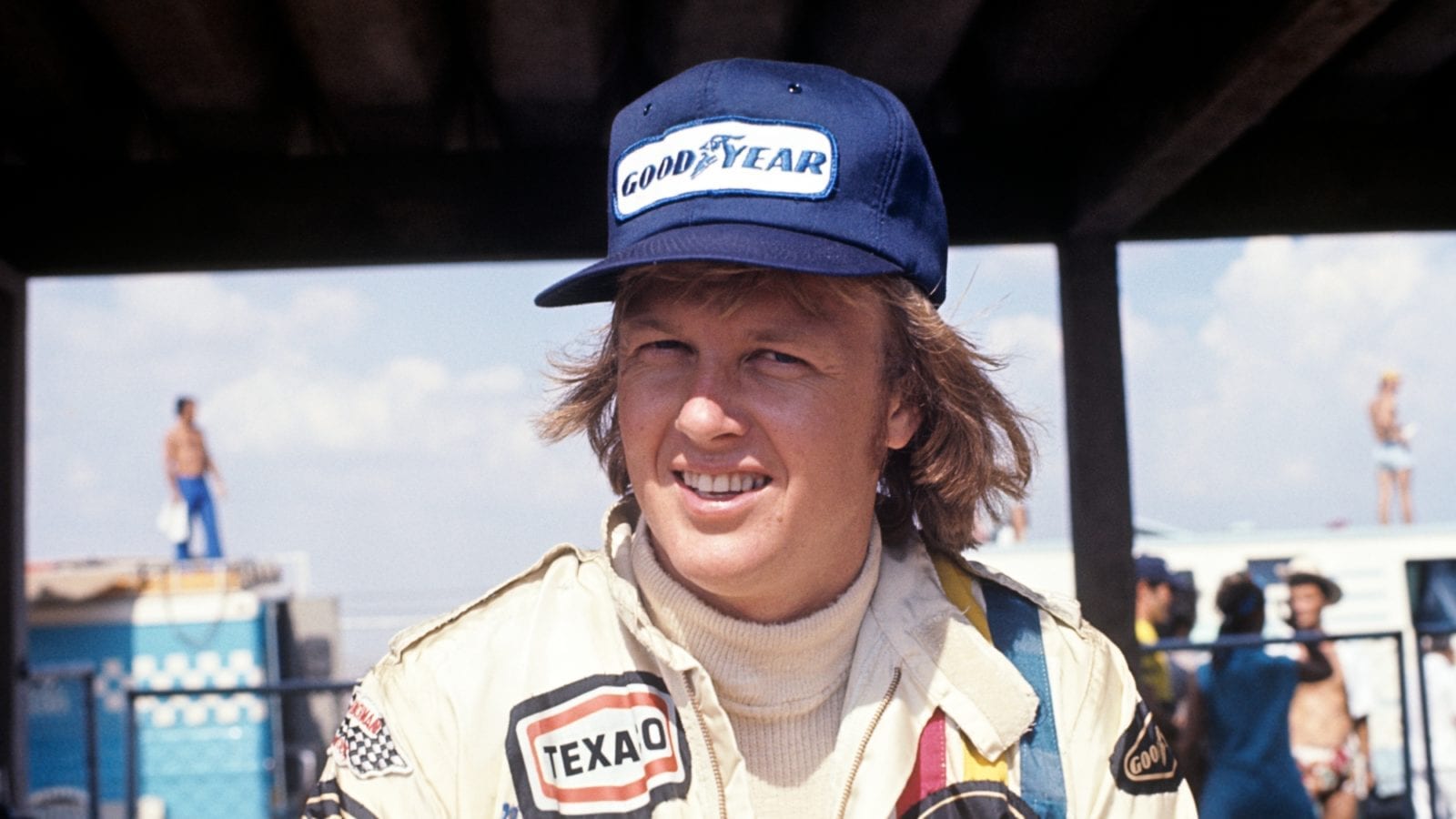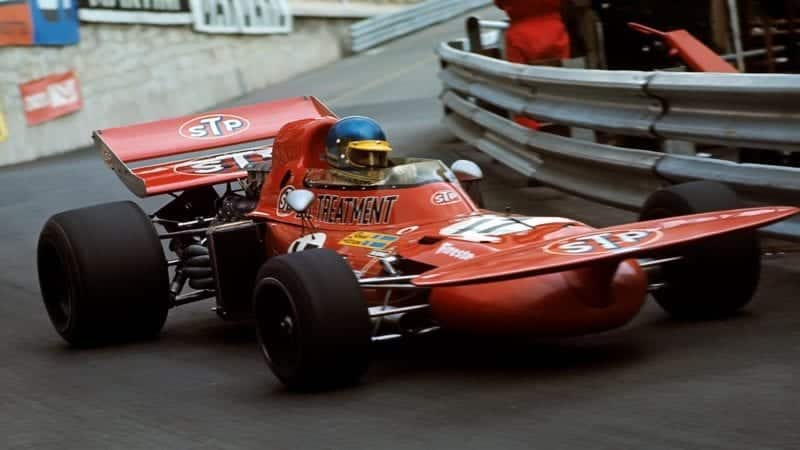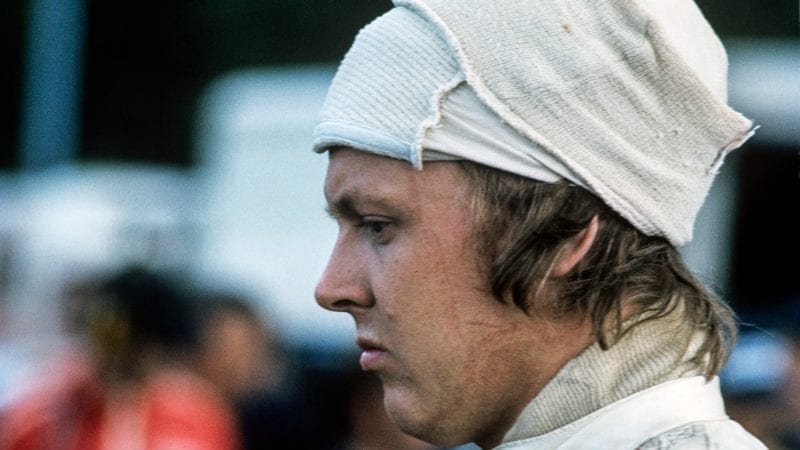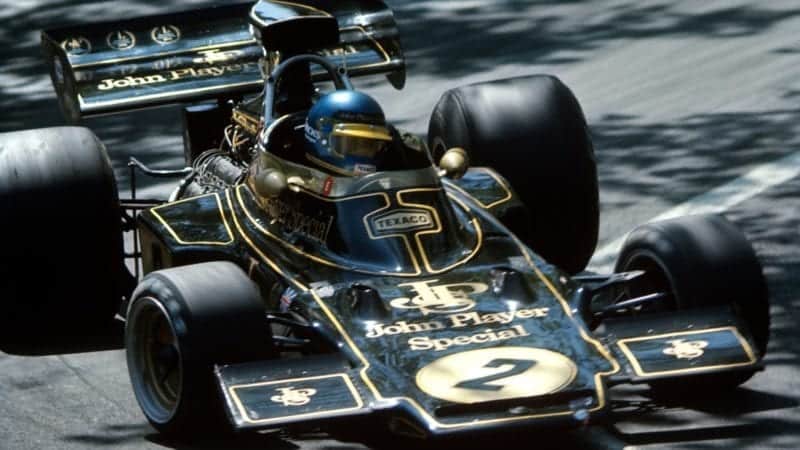My mate Ronnie
Alan Henry pays tribute to a good friend who was a great GP driver, and whose career was tragically cut short 30 years ago

Peterson smiles for the camera ahead of the 1973 South African GP
Bernard Cahier/Getty Images
Many of you, I’m certain, will remember him, head tilted slightly forwards, in the cockpit of that elegant gold pin-striped jet black JPS Lotus 72. Rear tyres chirping audibly as he slammed through Woodcote during practice for the 1973 British Grand Prix. Or perhaps skimming the barriers in the blood red STP March 711 on his way to second place behind Jackie Stewart in the 1971 Monaco Grand Prix. Or winning at Monza ’76 with the March 761, slightly against the odds, perhaps, but a great victory nonetheless.
The expression ‘going for it’ could have been coined for Ronnie Peterson, but for me the most vivid memories of this motor sporting giant are rooted in the rough-and-tumble of early 1970s Formula 2, that split-second cauldron of frenzied competition.
Ironically Max Mosley was the man who indirectly gave Ronnie Peterson the crucial final leg-up — and stop tittering at the back, if you don’t mind — which guaranteed that ‘SuperSwede’ would be in a position to vault straight into Formula 1 at the start of the 1970 season. No, I’m not talking about Mosley in his role as a director of March Engineering — although that would later be a crucial component in the Peterson story — but Max the failed future World Champion.
The occasion was the Albi F2 international in south west France in early September, 1969. Winkelmann Racing — then the McLaren of the ’60s second division, if you like — fielded a third car for Peterson. It was the Lotus 59 previously driven by Mosley — as modestly paced a racing driver as he was brilliant as a barrister — which had lain vacant since its driver retired from racing following a spill at the Nürburgring earlier in the year.
Ronnie finished fifth, but it was his performance in practice which really marked him out as something special in the eyes of Winkelmann team manager Alan Rees. “I simply couldn’t believe it,” he told me. “Ronnie happened to go out of the pits during a rain shower in practice and came up onto the tail of Jackie Stewart’s Matra and kept up with him for five laps on a soaking track.
“You could see Stewart glancing in his mirrors, trying to work out who was chasing him. He could see it was one of our Lotuses, but it wasn’t Graham Hill or Jochen Rindt driving it. That’s a real test of a driver, the wet, and Stewart had to come into the pits to get rid of him. I was 100 per cent sure that Ronnie would win Grands Prix on the strength of those five laps. It wasn’t speculation, it was obvious.”
Thus were laid the foundations of a career which would last for 123 Grands Prix across nine seasons, yielding 10 wins, 14 pole positions and runner-up status in the World Championship on two occasions. More significantly, Ronnie left a special legacy in that he was one of the very few drivers about whom I never heard a catty or vindictive remark. Even those who wanted to be annoyed with him found their resolve melting in the face of his sheepish, self-deprecating — and often guilty — grin.

Peterson at the wheel of his March-Ford in 1971 at Monaco
Bernard Cahier/Getty Images
I still find it hard to believe that 30 years have passed since that horrifying startline shunt at Monza left this fine man with legs so badly shattered that, within hours, a bone marrow embolism escaped into his bloodstream and killed him. It will come as no surprise, I’m sure, that I can still remember the precise place in the paddock where I last chatted with him.
“Morning, Albatross,” he said cheerfully. He’d called me that ever since the March F2 lads had introduced him and Niki Lauda to the zany, off-beat humour of Monty Python’s Flying Circus during his European Trophy-winning ’71 season. Looking back, quite how we explained to a baker’s boy from rural Sweden and a well-heeled banker’s son from Vienna precisely why shouting “Stormy Petrel on a stick” seemed so uproariously amusing is lost in the mists of time. But both Ronnie and Niki joined in and laughed politely. They must have thought we were barking.
I had first met Ronnie on a bright, breezy and very cold day at Silverstone. It was late January 1970. It was the launch of the March 701 and there was a media scrum the like of which you’ve rarely seen, even in today’s high profile world of intensely televised international sport. From one pit reigning World Champion Jackie Stewart, wearing an unusual tinted visor helicopter pilot’s helmet, was having his first run in the Tyrrell team’s dark blue 701. Further along, Chris Amon was getting to grips with the power and punch of a Cosworth DFV for the first time in his career, having turned his back on the Ferrari team the previous year after three largely fruitless seasons.
At the epicentre of all this activity were March directors Max Mosley and Robin Herd, both masters of the polished sales spiel, who spent their day ‘bigging up’ this latest commercial venture in their own uniquely compelling style.
Mingling in this crowd of racing personalities was a tall and curiously youthful-looking blond Swede wearing an ankle-length fur coat complete with an astrakhan collar. Both his wrists bore horrifying scarlet burns, the legacy of a frightening accident at the wheel of the prototype F3 March 693 the previous year at the Montlhery circuit near Paris. He looked much younger than his 27 years.
Outwardly he was a mild-mannered fellow who projected a cautiously unruffled charm. But when the visor on the front of that helmet snapped down, Peterson was transformed into a dazzlingly spectacular automotive acrobat.
The cut-and-thrust of Formula 3 would deliver the defining moment of Ronnie’s emergent career. Now equipped with one of the legendary, short wheelbase, kart-derived Tecno F3 cars, he journeyed to Monaco in 1969 to compete in the prestigious Grand Prix support race. Added piquancy was given to the battle by the fact that Ronnie would be going head-to-head with his arch-rival Reine Wisell, who was driving the works Chevron. Ronnie came home the clear winner.
Throughout his three-year F1 contract with the March team, Mosley was impressed with his loyalty. “He was the only driver I ever met who appreciated just what a risk we were taking offering him a three-year contract,” he confessed to me. “We paid him £2000 in 1970, £5000 in 1971 and £10,000 in 1972. He was totally loyal and would never have dreamed of breaking that commitment.”
Yet when that March contract expired, the lure of Lotus proved irresistible. Highly motivated, Ronnie could see that a very real possibility of challenging for the World Championship was now beckoning. Even though moving to Lotus was calculated to put sitting tenant Emerson Fittipaldi’s nose out of joint — he was the reigning title holder, after all — Ronnie grabbed the chance.
Fittipaldi won three races in 1973, Peterson four. But the two Lotus pace-setters spent much of the year inevitably taking points off each other. It allowed Jackie Stewart to dodge through to win his third championship, although the possibility of Fittipaldi retaining his crown remained on the cards right up to the Italian GP at Monza where he shadowed Ronnie for the entire distance, waiting for him to relinquish the lead as his own title bid was now over.
It says much for Peterson’s endearing character and infectious good nature that Fittipaldi attached no blame to Ronnie for his failure to concede the race: “My relationship with Ronnie remained absolutely fine, but it was never quite the same with Colin [Chapman] and, after that, I think it became clear to me that I would have to leave Lotus at the end of the season.”

Peterson ahead of the Swedish GP in 1973
Paul-Henri Cahier/Getty Images
Yet like so many great drivers, it is not simply the races he won which stand out in the memory. Watching at the Nürburgring in ’74, you could see that Ronnie still had the spark as he threw himself into a four-way fight with Jacky Ickx in the other Lotus, Mike Hailwood’s McLaren and local hero Jochen Mass. After 11 laps Mass’s superb drive in front of his home crowd came to an end when the engine in his Surtees TS16 suddenly failed. That left the two Lotus drivers fighting it out with Mike the Bike and I recall at the time thinking the whole thing seemed luridly precarious…
Disastrously, Mike’s McLaren landed slightly askew after leaping over the crest at Pflanzgarten. It speared right into the guard rail with a ferocious impact which left Hailwood with a badly broken ankle and out of racing for the rest of the season. In fact, Mike the Bike never raced again on four wheels through to his untimely death in 1981.
This led to suggestions — admittedly only from the sport’s wilder fringe — that Ronnie had been driving erratically in the heat of their battle, and that Mike’s injuries were somehow the by-product of the Swede’s recklessness.
When I mentioned this to Hailwood he sprang to Ronnie’s defence. “No, not at all,” he told me years after the accident. “I just can’t imagine that anybody could say such a terrible thing about that lovely guy. There was absolutely no way that Ronnie drove improperly. He never put a wheel wrong that I could remember.” Mike may have nicknamed him ‘Mad Ronald’ but I always got the impression that Hailwood, another real gentleman in every sense of the word, loved him like a brother.
Tim Schenken, who drove with Ronnie in the Ferrari sports car team throughout 1972, echoes Hailwood’s sentiments more than half a lifetime later. One of the handful of surviving ‘old guard’ from Peterson’s early days in F3 and F2, the genial Australian remembers his old friend with genuine pleasure and affection.
“Ronnie was a lovely guy who never changed from the moment I met him during our F3 days through to the time he died, by which time he was a world title contender,” recalls Schenken, now clerk of the course for the Australian GP in Melbourne.
Still as fit and trim as he was when he partnered Peterson at Ferrari 36 years ago, Schenken confesses that just talking about Ronnie brings a lump to his throat. “I must be getting old and sentimental, but Ronnie was totally uncomplicated with a really gentle side to his character.
“I first met him at Brands Hatch when we were racing in F3 in 1969. I used to guard all the details of my car’s technical set-up really closely, particularly the gear ratios, but when Ronnie innocently inquired ‘can you help me with the gear ratios?’ all my rules went out the window and I gave him all the help he needed.”
In 1971 his star quality was brilliantly underscored by his victory in the European F2 Trophy series. His sheer speed at the wheel of the March 712M was almost baffling to behold. There were several such cars contesting the championship, but Ronnie wrapped his around his little finger like a kart. It literally danced around the circuits of Europe, carrying its intrepid young driver to his greatest success as an aspiring star.
All of us in the close-knit F2 community regarded Ronnie as being let out of our sight on licence on alternate Sundays to compete in GPs. He was ours and we didn’t like sharing him with the snooty F1 brigade. And Ronnie seemed to understand that, even identify with it. He and his long-time girlfriend Barboro Edvardsson were our pitlane royalty and we jealously guarded our friendships with them both.
Clearly by now he was ready to win Grands Prix, but not until he switched to Lotus in 1973 would he be in the right place at the right time.

Peterson during the 1973 Spanish GP
Paul-Henri Cahier/Getty Images
Determined to prove he was still a World Championship contender, Ronnie gambled on rejoining Colin Chapman’s team in 1978 — but accepting number two status to Mario Andretti, freely acknowledging that the American’s great talent at test and development work had been responsible for making the new ground-effect Lotus 79 into the race-winning tool it was developed into.
It didn’t take long for the old Peterson to re-emerge; fast, focused and fitter than he had been before in his career. He was honourable enough to abide by his agreement to defer to Andretti, but by the same token he would make Mario work as hard as he could for every ounce of his well-deserved success.
Then came Monza and the brutal severing of the story line for thousands of F1 fans across the world. And for the writer, the end of a warm friendship with a man who, it always struck me, radiated genuine iconic status. Has there been anybody else like him? Perhaps. Two decades later, as I watched Mika Häkkinen really getting stuck in on a good day with his McLaren, I was aware of a certain familiarity resonating across the years. And in my mind’s eye I was back at Vallelunga, Brands Hatch or Mantorp Park.
Watching a yellow March F2 car, driven by my great hero, flying on the wings of the wind. Making the impossible seem possible again.
DSJ on…
A classic drive through the field by a ‘very determined’ Peterson
The South African GP was a remarkable race, with five different drivers leading in turn and the winner leading for the last half a lap. Even more remarkable was the fact that Peterson won the race from the sixth row of the grid; the whole affair a classic example of how unpredictable F1 can be and a good indication that a driver should never give up hope. Peterson’s performance was exemplary. He lost most of the first day of practice doing development driving with the Lotus-Getrag gearbox, and on the second day the wind and track were against him so that though he made a good time it did not compare with the first day’s times. This was why he was back in row six on the grid.
In the race he found his Lotus was lacking in top speed compared to the Williams, the Ligier, the Ferraris and the Renault, but it was handling beautifully round the corners. So what he made up on the bends the others pulled back on the straight, which is why he took so long to break away from the midfield bunch. On that final exciting lap he used the Lotus’s handling to the full in his chase of Depailler’s Tyrrell, and was happy to take corners on the wrong line and ‘sit-it-out’ with the Tyrrell. As the two cars went into the right-hand Sunset bend side by side, Hector Rebaque’s Lotus 78 was ahead and it seemed he was going to be in the way, but Peterson never caught the private Lotus. This was not because the Mexican pulled out a phenomenally fast lap, but because Peterson and Depailler were going relatively slowly in their wheel-to-wheel dice. It was exciting stuff to watch, but it was being done at the pace of the slowest cars. This does not detract from Peterson’s performance – it was heroic stuff and I wouldn’t have missed it for anything. Afterwards Depailler said: “Ronnie was very determined…”
It had been a memorable race and one that few people will forget in a hurry, with anguish and heartbreak for an incredible number of drivers, but the closing laps were ‘vintage’ Ronnie Peterson; something we have been lacking for too long.
April 1978
